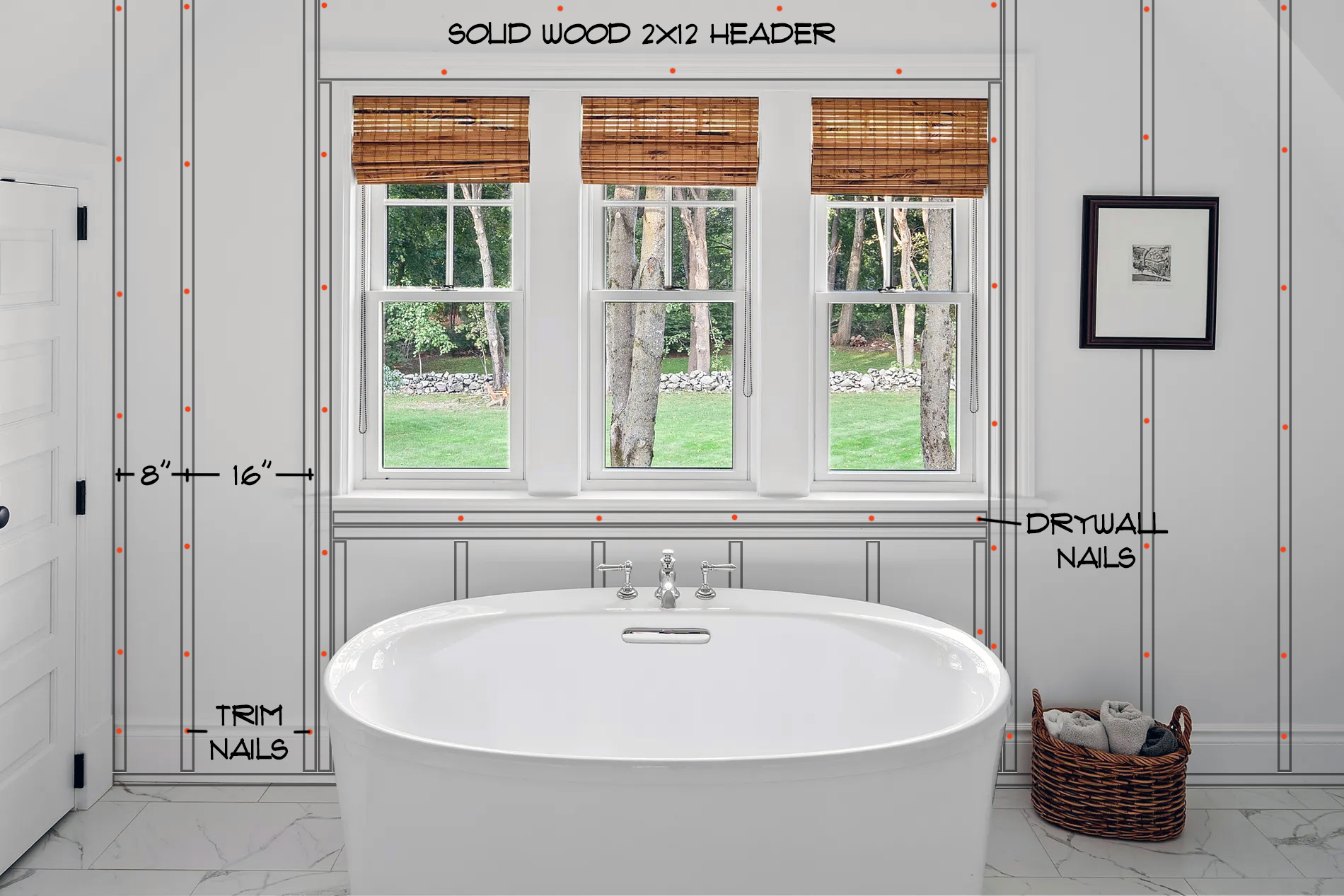How To Find A Stud Without A Stud Finder
Have you ever tried to hang something on the wall but had no idea where the studs were? I have, and it can be a real pain to find them. If you’re like me you’ve tried nailing a bunch of test holes in the wall hoping to find a stud. It’s a bad idea. A good quality stud finder definitely works but I don’t always have one with me at home or on the job. Luckily there are some really good ways to manually find a wall stud without a stud finder. But before you go looking for studs you should know some basic information about wall framing and where studs usually are.
Every home is different but most walls are framed pretty much the same as long as the house is built to code.
- Most homes are built with studs 16 inches on center starting from the corners.
- Wall studs can generally be found on the sides of windows and doors and next to outlets and switches. If you take the plate off an outlet or switch you can usually see a stud on the left or right side. The box holding the outlet or switch will be nailed into the stud.
Trim in the house is usually nailed to a stud. If you inspect the trim or feel it with a finger tip you can sometimes find the nails. This will indicate where a stud is. Drywall is generally secured to wall studs with metal nails or screws. Run a magnet across the wall to find the find the fasteners and a wall stud. You can also find studs by banging on the wall. Hitting a stud feels and sounds different than knocking on a void.
Now let’s discuss how to find a stud manually in more detail.
How To Find A Wall Stud Tricks
There are a few tricks I’ve learned over the years that help me find a wall stud without a stud finder. We’ll discuss those below. But first lets talk a little more about wall studs. It’s important to understand a little about how a wall is framed because it makes it easier to find the studs.
Take a look at the diagram shown above. It shows how a wall is framed in a typical bathroom.
- Studs are spaced at least 16″ on center. However, by the left wall the studs are closer because there isn’t enough room. This is very common, especially in homes with lots of windows. Windows are framed to support the window so they’re framed differently.
- Notice the windows have one stud supporting the 2×12 header, one stud running along side the header, and one stud supporting the double 2×4 or 2×6 under the window. The short studs under the window are typically spaced at 16″ on center.
Notice the red dots, those represent nails. As you can see the base trim is nailed into the studs. Drywall nails or screws are spaced approximately 12″- 16″ apart and run up the stud from floor to ceiling. These are easy to find with a magnet.
All homes are framed a little different based on room sizes and window/door location, but general framing rules like these still apply. Understand basic wall framing will help you locate wall studs without a stud finder. It makes hanging a picture directly on a stud easy.
How To Find A Wall Stud With A Magnet
Drywall is secured to wall studs using metal nails or screws. Both of which will stick to a magnet.
To find a wall stud using a magnet, simply run the magnet along the wall until it sticks to something. You’ll feel he magnet start to pull as it gets close to a nail or screw. Once you find one, mark the spot with a pencil. Then run the magnet straight up or down the wall from the mark. I usually try to find 2-3 nails in a row before I’m sure it’s a stud and not some other metal thing in the wall.
The stronger the magnet the better this will work. If you’ve got 1/2 inch drywall a regular fridge magnet may work. But for thicker drywall use something stronger. I have a small pocket level with a magnet on the back that works great. And it only cost like 10 bucks. The level is actually cheaper than most stud finders so it was a great deal.
How To Find A Wall Stud With A Tape Measure
Studs are located every 16 inches on center in most homes built to code. This means you can usually find studs by measuring in from the corners.
Keep in mind that not all rooms are built in numbers divisible by 16″. This means one end of the wall will have a stud that’s less than 16 inches on center. For this reason I usually measure to find studs from both corners. Once I mark where I think studs should be, I knock test the area or use a magnet to make sure my marks are correct.
Doors and windows are framed with studs on the sides to hold up the header and support the frame. You can use this as a starting point to find studs with a tape measure too. Studs will be no more than 16 inches on center away from a door or window frame.
Outlets and switches are normally nailed to a stud. Take the plate off and look inside. You’ll see either the stud itself or the nails that attach the box to the stud. Measure out from there to find more wall studs.
Once you find a stud, measure 16 inches to find the location of the next one. Look for the same signs of a stud in that area. Knock on the wall with your knuckles and listen for a solid sound instead of a hollow one or use a magnet.
A tape measure is a great way to find wall studs without a stud finder but it assumes the wall is framed to code. I use the tape as a guide to mark where I think studs should be. But I generally try to confirm it by knocking, using a magnet or looking for other signs before I nail into the wall.
How To Find A Wall Stud By Knocking The Wall
A great way to find a wall stud is by knocking. Tap the wall with your knuckles or finger tip and listen. When you hit or get close to a stud it’ll sound different than when you’re tapping by a void between studs. The drywall will also feel a little more solid which brings me to the next tip.
Bang the wall with the side of your fist. Not so hard that you damage the wall or your hand, but hard enough that you can feel how solid the wall is. When you hit a stud it won’t give at all. But when you hit a void you’ll feel a little give in the drywall. Don’t worry, it won’t damage the wall if you do it correctly. This will also make a sound that’s different depending on what you hit inside the wall.
Find A Stud By Inspecting The Trim
Trim that runs across the wall is generally secured by nailing it to studs. This includes base and crown molding. Once the trim is nailed in, the nail heads are usually sunk and filled with wood filler or caulk. Then painted or stained. These nail holes are commonly referred to as dimples.
If the trim is stained it’s easier to spot the nails. Usually fillers will stain a little darker than the wood making them easy to spot.
Painted trim is a little harder if they did a good job filling and sanding the holes. Look closely to see if there’s any indication of where a nail might be. It helps to run your finger over the trim. You can sometimes feel areas that were filled even when you can’t see them. A filled section usually indicates a nail.
If you find a nail, check above it with other means like a magnet, knocking or tape measure. Once certain you’ve found a stud, measure in 16″ increments to locate additional studs.
Find A Stud Using Outlets & Switches
Generally speaking, at least one side of an outlet and light switch will be mounted on a stud. Take off the plate and inspect inside. You can sometimes see the stud by looking into the space between the drywall and outlet box. You can also look inside the box itself to find the nails. Outlet boxes are secured to studs using two nails located on one side or the other.
If you can’t see the stud or nails, tap the sides of the outlet to locate which side has the stud or use a magnet. Measure about 3/4″ from the outlet on the stud side and make a mark. Use the mark as a starting point to measure 16″ out from. This will help find more studs.
Find Studs By Inspecting With A Flashlight
When drywall is hung it’s either nailed or screwed about 12 inch on center vertically to the studs. This creates a row of nails from the bottom of the wall to the top. These nails are later spackled, sanded smooth and painted. But even though they appear perfectly smooth in normal light from most angles. Sometimes you can still see them.
Take a flashlight and shine it along the wall at a steep angle. Position your head right next to the wall and look down the wall. You can sometimes see very small bumps in the drywall where rows of nails were spackled and sanded down. Once you find one, take your hand and feel across it. You’ll be able to feel a very subtle change in depth.
To confirm the nails are there, use a tape measure, magnet or tap the wall. I usually try to spot nails with two methods before I start driving nails or screws into the wall.
In some cases workers just don’t do a good job of finishing the drywall. Spackle may be over-sanded or not sanded enough. This creates either a bump where nails are covered or an inward shaped dimple where spackle was over-sanded. Sometimes these imperfections are so bad they can be seen without the flashlight in natural light. When you see them you’ve found a stud.
Look For Nail Pops
Drywall is either installed with nails or screws. In my opinion screws are better because they don’t pull out.
Nails can start to pull out over time because houses move. Wood contracts and expands with temperature changes, houses settle and wind can rock a house. All of these things can push nails out of the wood and against the drywall. This causes a nail pop.
Nail pops are very easy to spot. They look like little round dimples about an inch or so across. Under each pop is a nail working it’s way out of the wood. These are sure signs of stud.
Find A Wall Stud Using Vents
Another way to find a wall stud is by using the vents. This is the same basic method as using switches and outlets. Wall vents are generally located in between two studs. Metal straps stick out the side of the vent and are nailed into the studs. If you find a wall vent, there are studs to either side.
Measure the vent’s width. This will help you determine how far to the right or left the studs are. The gap between two studs spaced at 16 inches on center is approximately 14 1/2 inches. Subtract the width of the vent from 14 1/2 and then cut that number in half. This will tell you approximately where the vents are.
For example, lets say you have a 10 inch vent. The gap between studs is usually about 14 1/2 inches. Subtracting 10 from 14 1/2 gives you 4 1/2 inches. Split that in half and the studs should be approximately 2 1/4 inch to the right and left of the vent. This assumes the vent is dead center between the studs and it may not be. The vent could be located slightly more left or right in the gap. So use these measurements as a guide.
Once you know about where the studs are, use other methods to narrow them down. I recommend knocking on the wall or using a magnet.
Nail Test
I don’t recommend driving nails all over the place searching for a stud. But once you’ve found a spot you think one should be, drive a thin nail or screw into the wall and confirm it.
If you miss a stud but think there’s one really close, stick in some wire and poke around to the sides. I like to use a coat hanger. Sometimes you can miss a stud by just a smidge but can find it without driving in more test nails. Once you find the edge of the stud with your wire, make a mark. Then measure in 3/4 of an inch. This will give you the center of the stud. Drive in another test nail to be sure.
Find Studs In A Wall By A Fireplace
Finding studs in a wall by a fireplace is easy. A fireplace opening is framed just like a window with one stud holding up the header and one running along side it. Check out the drawing shown above.
Mark the studs on the sides of the fireplace first. These are the easiest to find. Then start measuring out 16 inches at a time in both directions. Double check your measurements against outlets, switches, vents and windows. Knock the walls and use magnets to narrow down where studs are. Also measure in from the corners.
Using multiple methods is the best way to find wall studs without a stud finder. I never rely on just one method. Use measurements to give a rough idea of stud locations and then use knocking or a magnet to confirm.
The only time you can know for sure where a wall stud is without double checking is on either side of the firebox. A fireplace is supposed to be supported by a header and that header is held up by studs on both ends. However, this assumes the wall is properly framed.
Summary: How To Find A Wall Stud Manually Without A Stud Finder
Have you ever tried hanging something on the wall but had no idea where the studs were? I have, and it can be a real pain to find them. If you’re like me you’ve tried nailing a bunch of test holes in the wall hoping to find a stud. It’s a bad idea. A good quality stud finder definitely works but I don’t always have one with me at home or on the job. Luckily there are some really good ways to manually find a wall stud without a stud finder. But before you go looking for studs you should know some basic information about wall framing and where studs usually are.
Every home is different but most walls are framed pretty much the same as long as the house is built to code.
- Most homes are built with studs 16 inches on center starting from the corners.
- Wall studs can generally be found on the sides of windows and doors and next to outlets and switches. If you take the plate off an outlet or switch you can usually see a stud on the left or right side. The box holding the outlet or switch will be nailed into the stud.
Trim in the house is usually nailed to a stud. If you inspect the trim or feel it with a finger tip you can sometimes find the nails. This will indicate where a stud is. Drywall is generally secured to wall studs with metal nails or screws. Run a magnet across the wall to find the find the fasteners and a wall stud. You can also find studs by banging on the wall. Hitting a stud feels and sounds different than knocking on a void.
If you have any questions or comments about wall studs, email any time.






















